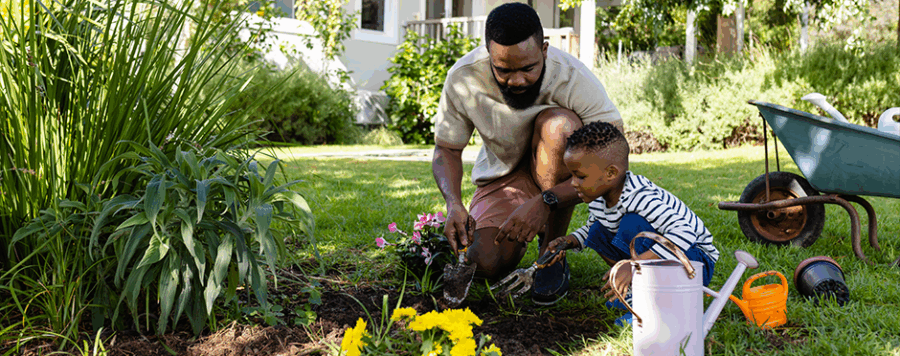Warm Up and Loosen Up
Since gardening requires movements like squatting, lifting, pushing, and pulling, it’s critical to warm up the body the way you would prior to an athletic activity. This may include performing 10 reps of the following stretches.
- Lacing your fingers together and reaching both hands over your head, and holding them for 10 to 15 seconds
- Gentle backward shoulder circles
- With your hands crossed at your chest, rotate your spine slowly from side to side
- Standing and bringing one knee up towards your chest, then relax and repeat on the other side
- Standing and raising on the balls of the feet, and then slowly lowering
Lifting: The strain of lifting heavier objects can be lessened when you remember to lift with your legs and to avoid twisting or turning while lifting. A wheelbarrow can aid in moving larger or heavier objects. Don’t hesitate to ask for help and share the load with a garden buddy.
Weeding: It is important to avoid bending at your back to pull weeds. Instead, bend at your knees and hips. You may want to consider using long-handed tools to reduce your body’s strain and help eliminate those pesky weeds. A Hula Hoe/Stirrup hoe is designed to be used with a back-and-forth motion that easily cuts through weeds. Sitting on a garden stool or kneeling on a padded surface also helps to bring you closer to the work area and less stress on the knees or lower back. Just remember to bend forward at your hips versus hunch over at your back.
Take Breaks: At the beginning of the gardening season, you’ll want to list tasks to complete and pace yourself. At first, you may want to take a break every 20-30 minutes to sit and rest. Be sure to remember to hydrate during this break and wear sunscreen to protect your skin.
Planting: To plant your crops, you’ll need to turn your soil and dig holes. Using a long-handled shovel that has been sharpened will make these tasks easier and more efficient. Once the soil is prepped, it’s time to plant. To reduce strain in the back and the knees, you can use a garden seat or a kneeling stool to place yourself closer to the work surface. Either of these options will limit the stress on your body while you’re digging your new garden.
Raised Garden Bed: If you have physical limitations of your knees or back, a good option is raised garden beds. These beds are commonly made of wood or metal and are 12” to 18” above the ground, making tending your garden easier.
These tips should have you digging the spring garden in no time. Remember that gardening is a physical activity, so take breaks, work in good posture, and use the right tools for the task. If aches and soreness are keeping you from enjoying your garden, you can book a free assessment with one of our physical therapists so we can help alleviate your symptoms and have you using your green thumb again.
*Per federal guidelines, beneficiaries of plans such as Medicare, Medicaid, Tricare, VHA and other federally funded plans are not eligible for free assessments.
The Athletico blog is an educational resource written by Athletico employees. Athletico bloggers are licensed professionals who abide by the code of ethics outlined by their respective professional associations. The content published in blog posts represents the opinion of the individual author based on their expertise and experience. The content provided in this blog is for informational purposes only, does not constitute medical advice and should not be relied on for making personal health decisions.

 width="900"
height="356"
>
width="900"
height="356"
>
